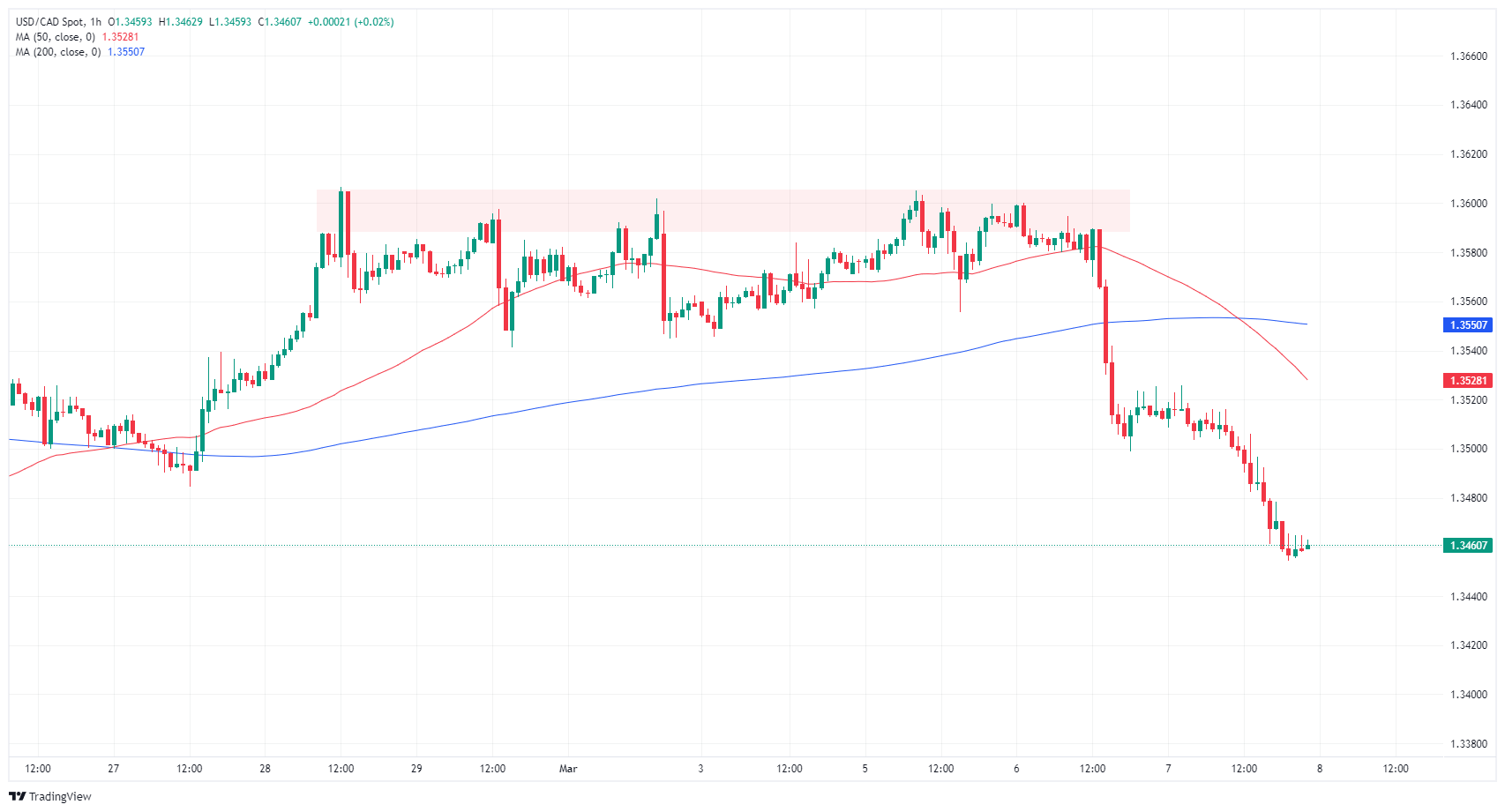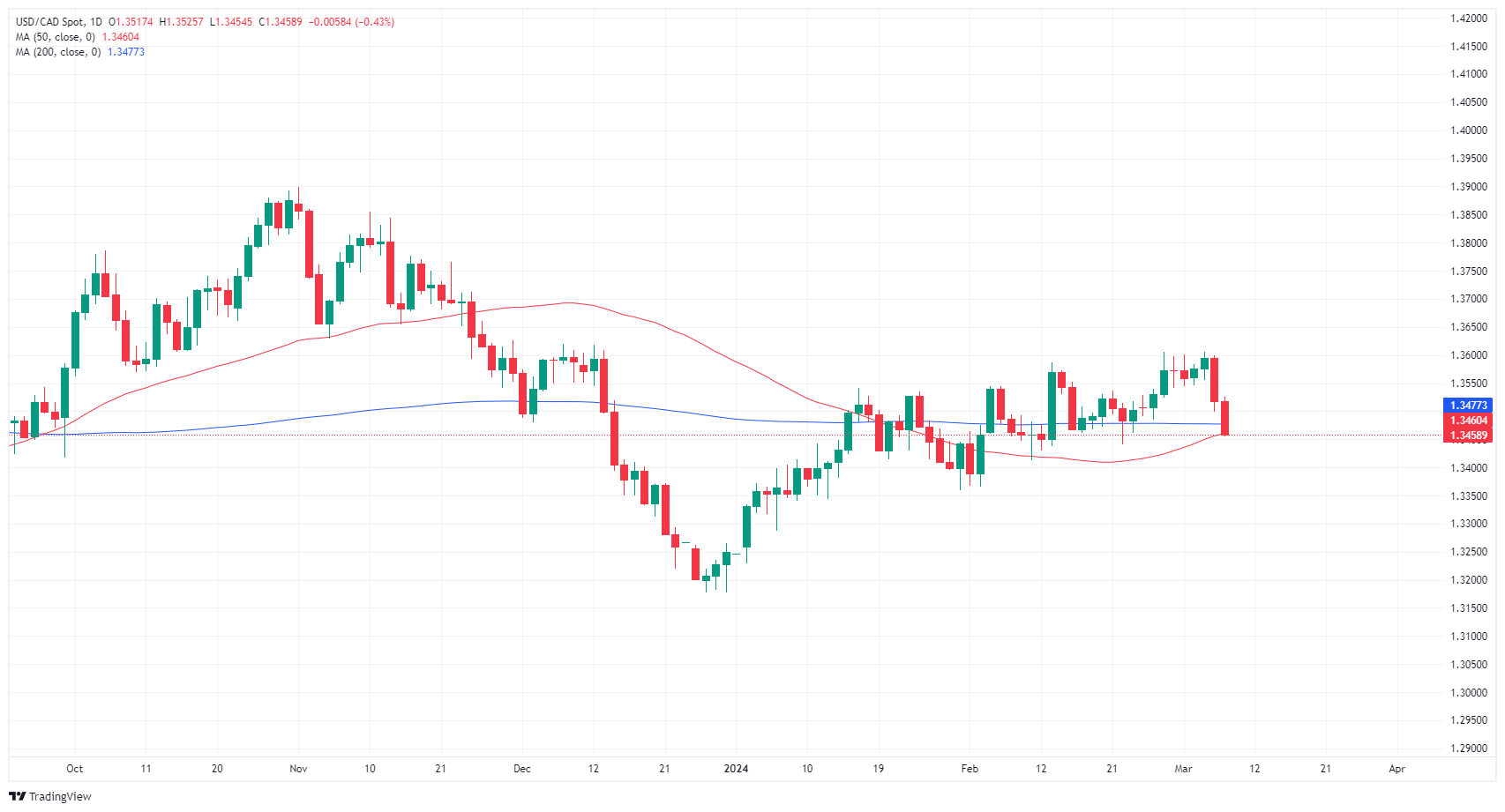- Canadian Dollar mixed on the day but climbs over US Dollar.
- Canada brings its own labor figures to US NFP Friday.
- USD/CAD breaks down below 1.3500 on weaker Greenback flows.
The Canadian Dollar (CAD) found some room on the high end above the US Dollar (USD) on Thursday. The USD/CAD pair slipped below the 1.3500 handle as markets buckle down for the wait to Friday’s US Nonfarm Payrolls (NFP) jobs report.
Canada answers the US NFP print with labor figures of its own on Friday. American markets will be switching to Daylight Savings Time this weekend, while Canada will be largely absent from the economic calendar with strictly low-tier data on offer next week. However, plenty of US data will arrive to drive the markets, with February’s US Consumer Price Index (CPI) inflation slated for next Tuesday.
Daily digest market movers: Markets pull away from Greenback as investors await key data
- Canada’s MoM Building Permits jumped to a seven-month high of 13.5% in January, well above the 5.5% forecast and recovering from the previous month’s -11.5% decline (which was revised upward from -14.0%).
- US Initial Jobless Claims for the week ended March 1 printed slightly above expectations, coming in at 217K versus the forecast 215K, while the previous week saw a revision to 217K from 215K.
- Initial Jobless Claims came in above the four-week average of 212.25K.
- US Nonfarm Productivity in the fourth quarter held steady at 3.2% compared to the forecast of a tick lower to 3.1%.
- US Q4 Unit Labor Costs ticked down to 0.4% from the previous 0.5%, missing the forecasted uptick to 0.6%.
- Federal Reserve (Fed) Chairman Jerome Powell testifies before the US Senate Banking Committee in the second of a two-day Q&A about the Fed’s Semi-Annual Monetary Policy Report.
- Canada’s Unemployment Rate is expected to tick higher from 5.7% to 5.8% on Friday.
- Canadian Net Change in Employment in February is forecast to print at 20K versus the previous month’s 37.3K.
- Friday’s US NFP print is expected to come in at 200K for February, down from January’s 11-month peak of 353K.
- NFP Preview: Forecasts from 10 major banks, employment continues to rise strongly.
Canadian Dollar price today
The table below shows the percentage change of Canadian Dollar (CAD) against listed major currencies today. Canadian Dollar was the strongest against the US Dollar.
| USD | EUR | GBP | CAD | AUD | JPY | NZD | CHF | |
| USD | -0.45% | -0.56% | -0.38% | -0.79% | -0.85% | -0.73% | -0.55% | |
| EUR | 0.45% | -0.11% | 0.07% | -0.34% | -0.39% | -0.30% | -0.09% | |
| GBP | 0.56% | 0.13% | 0.17% | -0.25% | -0.29% | -0.18% | 0.03% | |
| CAD | 0.40% | -0.03% | -0.17% | -0.44% | -0.45% | -0.38% | -0.14% | |
| AUD | 0.81% | 0.37% | 0.25% | 0.42% | -0.03% | 0.03% | 0.27% | |
| JPY | 0.84% | 0.39% | 0.28% | 0.44% | 0.06% | 0.10% | 0.30% | |
| NZD | 0.74% | 0.32% | 0.20% | 0.38% | -0.03% | -0.07% | 0.22% | |
| CHF | 0.51% | 0.10% | -0.02% | 0.15% | -0.26% | -0.29% | -0.22% |
The heat map shows percentage changes of major currencies against each other. The base currency is picked from the left column, while the quote currency is picked from the top row. For example, if you pick the Euro from the left column and move along the horizontal line to the Japanese Yen, the percentage change displayed in the box will represent EUR (base)/JPY (quote).
Technical analysis: USD/CAD drifts into the low side as Greenback waffles
The Canadian Dollar (CAD) found room above the US Dollar on Thursday, climbing around a third of a percent against the Greenback, but overall the Loonie is moderately softer across the broader FX market. The CAD lost around half a percent against the Japanese Yen (JPY), the Australian Dollar (AUD) and the New Zealand Dollar (NZD). The Canadian Dollar is flat against the Euro (EUR) as both currencies struggle to find moves.
USD/CAD found a near-term floor at 1.3500 on Wednesday, and Thursday’s US Dollar-bearish flows finished the job, knocking the pair toward 1.3460. The Dollar-Loonie pair is down around a full percent from the week’s peak bids at 1.3605.
Thursday’s decline drags the USD/CAD pair back into the 200-day Simple Moving Average (SMA) at 1.3477, and the immediate technical floor is priced in at the last meaningful swing low toward 1.3350.
USD/CAD hourly chart
USD/CAD daily chart
Canadian Dollar FAQs
The key factors driving the Canadian Dollar (CAD) are the level of interest rates set by the Bank of Canada (BoC), the price of Oil, Canada’s largest export, the health of its economy, inflation and the Trade Balance, which is the difference between the value of Canada’s exports versus its imports. Other factors include market sentiment – whether investors are taking on more risky assets (risk-on) or seeking safe-havens (risk-off) – with risk-on being CAD-positive. As its largest trading partner, the health of the US economy is also a key factor influencing the Canadian Dollar.
The Bank of Canada (BoC) has a significant influence on the Canadian Dollar by setting the level of interest rates that banks can lend to one another. This influences the level of interest rates for everyone. The main goal of the BoC is to maintain inflation at 1-3% by adjusting interest rates up or down. Relatively higher interest rates tend to be positive for the CAD. The Bank of Canada can also use quantitative easing and tightening to influence credit conditions, with the former CAD-negative and the latter CAD-positive.
The price of Oil is a key factor impacting the value of the Canadian Dollar. Petroleum is Canada’s biggest export, so Oil price tends to have an immediate impact on the CAD value. Generally, if Oil price rises CAD also goes up, as aggregate demand for the currency increases. The opposite is the case if the price of Oil falls. Higher Oil prices also tend to result in a greater likelihood of a positive Trade Balance, which is also supportive of the CAD.
While inflation had always traditionally been thought of as a negative factor for a currency since it lowers the value of money, the opposite has actually been the case in modern times with the relaxation of cross-border capital controls. Higher inflation tends to lead central banks to put up interest rates which attracts more capital inflows from global investors seeking a lucrative place to keep their money. This increases demand for the local currency, which in Canada’s case is the Canadian Dollar.
Macroeconomic data releases gauge the health of the economy and can have an impact on the Canadian Dollar. Indicators such as GDP, Manufacturing and Services PMIs, employment, and consumer sentiment surveys can all influence the direction of the CAD. A strong economy is good for the Canadian Dollar. Not only does it attract more foreign investment but it may encourage the Bank of Canada to put up interest rates, leading to a stronger currency. If economic data is weak, however, the CAD is likely to fall.
Nonfarm Payrolls FAQs
Nonfarm Payrolls (NFP) are part of the US Bureau of Labor Statistics monthly jobs report. The Nonfarm Payrolls component specifically measures the change in the number of people employed in the US during the previous month, excluding the farming industry.
The Nonfarm Payrolls figure can influence the decisions of the Federal Reserve by providing a measure of how successfully the Fed is meeting its mandate of fostering full employment and 2% inflation. A relatively high NFP figure means more people are in employment, earning more money and therefore probably spending more. A relatively low Nonfarm Payrolls’ result, on the either hand, could mean people are struggling to find work. The Fed will typically raise interest rates to combat high inflation triggered by low unemployment, and lower them to stimulate a stagnant labor market.
Nonfarm Payrolls generally have a positive correlation with the US Dollar. This means when payrolls’ figures come out higher-than-expected the USD tends to rally and vice versa when they are lower. NFPs influence the US Dollar by virtue of their impact on inflation, monetary policy expectations and interest rates. A higher NFP usually means the Federal Reserve will be more tight in its monetary policy, supporting the USD.
Nonfarm Payrolls are generally negatively-correlated with the price of Gold. This means a higher-than-expected payrolls’ figure will have a depressing effect on the Gold price and vice versa. Higher NFP generally has a positive effect on the value of the USD, and like most major commodities Gold is priced in US Dollars. If the USD gains in value, therefore, it requires less Dollars to buy an ounce of Gold. Also, higher interest rates (typically helped higher NFPs) also lessen the attractiveness of Gold as an investment compared to staying in cash, where the money will at least earn interest.
Nonfarm Payrolls is only one component within a bigger jobs report and it can be overshadowed by the other components. At times, when NFP come out higher-than-forecast, but the Average Weekly Earnings is lower than expected, the market has ignored the potentially inflationary effect of the headline result and interpreted the fall in earnings as deflationary. The Participation Rate and the Average Weekly Hours components can also influence the market reaction, but only in seldom events like the “Great Resignation” or the Global Financial Crisis.
Information on these pages contains forward-looking statements that involve risks and uncertainties. Markets and instruments profiled on this page are for informational purposes only and should not in any way come across as a recommendation to buy or sell in these assets. You should do your own thorough research before making any investment decisions. FXStreet does not in any way guarantee that this information is free from mistakes, errors, or material misstatements. It also does not guarantee that this information is of a timely nature. Investing in Open Markets involves a great deal of risk, including the loss of all or a portion of your investment, as well as emotional distress. All risks, losses and costs associated with investing, including total loss of principal, are your responsibility. The views and opinions expressed in this article are those of the authors and do not necessarily reflect the official policy or position of FXStreet nor its advertisers. The author will not be held responsible for information that is found at the end of links posted on this page.
If not otherwise explicitly mentioned in the body of the article, at the time of writing, the author has no position in any stock mentioned in this article and no business relationship with any company mentioned. The author has not received compensation for writing this article, other than from FXStreet.
FXStreet and the author do not provide personalized recommendations. The author makes no representations as to the accuracy, completeness, or suitability of this information. FXStreet and the author will not be liable for any errors, omissions or any losses, injuries or damages arising from this information and its display or use. Errors and omissions excepted.
The author and FXStreet are not registered investment advisors and nothing in this article is intended to be investment advice.
Recommended content
Editors’ Picks

EUR/USD trades sideways below 1.0450 amid quiet markets
EUR/USD defends gains below 1.0450 in European trading on Monday. Thin trading heading into the Xmas holiday and a modest US Dollar rebound leaves the pair in a familair range. Meanwhile, ECB President Lagarde's comments fail to impress the Euro.

GBP/USD stays defensive below 1.2600 after UK Q3 GDP revision
GBP/USD trades on the defensive below 1.2600 in the European session on Monday. The pair holds lower ground following the downward revision to the third-quarter UK GDP data, which weighs negatively on the Pound Sterling amid a broad US Dollar uptick.

Gold price sticks to modest gains; upside seems limited amid USD dip-buying
Gold price attracts some follow-through buying at the start of a new week and looks to build on its recovery from a one-month low touched last Thursday. Geopolitical risks stemming from the protracted Russia-Ukraine war and tensions in the Middle East, along with trade war fears, turn out to be key factors benefiting the safe-haven precious metal.

The US Dollar ends the year on a strong note
The US Dollar ends the year on a strong note, hitting two-year highs at 108.45. The Fed expects a 50-point rate cut for the full year 2025 versus 4 cuts one quarter earlier, citing higher inflation forecasts and a stubbornly strong labour market.

Bank of England stays on hold, but a dovish front is building
Bank of England rates were maintained at 4.75% today, in line with expectations. However, the 6-3 vote split sent a moderately dovish signal to markets, prompting some dovish repricing and a weaker pound. We remain more dovish than market pricing for 2025.

Best Forex Brokers with Low Spreads
VERIFIED Low spreads are crucial for reducing trading costs. Explore top Forex brokers offering competitive spreads and high leverage. Compare options for EUR/USD, GBP/USD, USD/JPY, and Gold.